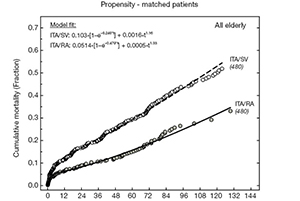Radial artery as a second arterial graft in the elderly and both sexes
Abstract
Background: Use of multiple arterial grafts for surgical coronary revascularization remains limited in scope worldwide, and is disproportionately low in two growing segments of coronary artery disease patients— women and the elderly. While a prevailing practice, this trend is not supported by objective data. This report discusses two recent reports that support the liberal use of the radial artery (RA) as a second arterial conduit, in the elderly and irrespective of sex, instead of the conventional operation based on a single internal thoracic artery (ITA) with additional vein grafts.
Methods: From 1996 to 2007, 6,384 patients underwent primary, non-salvage emergency coronary artery bypass grafting with at least 2 complete grafts (including one ITA graft) were included in the present analysis. Those with bilateral ITA, ITA-only grafts, or concomitant valve/aortic surgery were excluded. 2,605 patients aged 70 or greater were further included in a subsequent analysis. Patients were further matched on propensity score models based on ITA/RA versus ITA/saphenous vein (SV) grafts.
Results: 69% of all included patients were male. Propensity models yielded 1,416 ITA/RA and ITA/SV matched pairs in men and 567 pairs in women. Operative mortality was similar for both graft combinations in men and women, while late mortality was significantly lower for ITA/RA subcohorts in both sexes. Matched Kaplan-Meier cumulative mortality was significantly better for ITA/RA irrespective of sex (men: risk reduction=0.65, P<0.001; women: RR=0.75, P=0.045). In patients aged 70 years or older, operative death was essentially identical for ITA/RA vs. ITA/SV (2.31% vs. 2.31%; P=0.880). Patients undergoing ITA/ RA grafting had significantly better unadjusted 12-year survival. In 480 elderly matched pairs, cumulative mortality at 1, 5, and 10 years was significantly better for the ITA/RA cohort.
Conclusion: The discussed data showed a clinically significant improvement in intermediate (1-5 years) and late (>5 years) survival with multiple arterial grafts in female and male patients and in the elderly. The latter was true for both the septuagenarian and octogenarian subgroups. Importantly, the choice of the RA as the second arterial conduit seems to be associated with low associated perioperative risks, and avoids the potential for sternal healing complications due to bilateral ITA dissection in certain patients.
Cover






